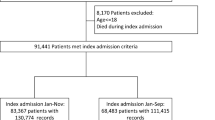Abstract
There is increasing regulatory pressure for cost containment in neuro-oncology, and rationalization of the observed regional disparities. We investigated the presence of such disparities in New York State and examined the impact of risk adjustment on the magnitude of this variation. We performed a cohort study involving patients with brain tumors (gliomas, metastases, or meningiomas), who underwent craniotomy for resection from 2009 to 2013, and were registered in the Statewide Planning and Research Cooperative System (SPARCS) database. A linear regression model was utilized for risk-adjustment of inpatient charges using socioeconomic factors and comorbidities. Hospitals with fewer than 20 craniotomies were excluded. 13,535 patients underwent treatment, including 5032 (37.2 %) gliomas, 4858 (35.9 %) metastases, and 3645 (26.9 %) meningiomas. Unadjusted median hospitalization charges ranged from $22,954 to $177,398 at the hospital level, and $30,086 to $159,281 at the county level. Despite extensive risk-adjustment we observed persistent disparities with median hospitalization charges ranging from $40,455 to $124,691 at the hospital level, and $53,999 to $94,844 at the county level. Analysis of variance (ANOVA) demonstrated that these disparities were significant at the facility and the county level (P < 0.0001). Increased charges were not associated with shorter LOS (r = 0.10, P = 0.41), or lower rates of death (r = 0.09, P = 0.46), and unfavorable discharge (r = 0.24, P = 0.06). Using a comprehensive all-payer cohort of patients with brain tumors in New York State we identified wide disparities at the hospital and the county level despite comprehensive risk-adjustment. Increased charges were not associated with shorter LOS, or lower rates of death and unfavorable discharge.



Similar content being viewed by others
References
Wennberg JE, Cooper MM (1999) The Dartmouth Atlas of Healthcare. American Hospital Publishing, Chicago
Fisher ES, McClellan MB, Safran DG (2011) Building the path to accountable care. N Engl J Med 365:2445–2447
Fisher ES, Shortell SM (2010) Accountable care organizations: accountable for what, to whom, and how. JAMA 304:17115–17116
Fisher ES, Wennberg DE, Stukel TA, Gottlieb DJ (2004) Variations in the longitudinal efficiency of academic medical centers. Health Aff (Millwood) Suppl Variation:VAR19-32
Fisher ES, Wennberg DE, Stukel TA, Gottlieb DJ, Lucas FL, Pinder EL (2003) The implications of regional variations in Medicare spending. Part 1: the content, quality, and accessibility of care. Ann Intern Med 138:273–287
Fisher ES, Wennberg DE, Stukel TA, Gottlieb DJ, Lucas FL, Pinder EL (2003) The implications of regional variations in Medicare spending. Part 2: health outcomes and satisfaction with care. Ann Intern Med 138:288–298
Fisher ES, Wennberg JE (2003) Health care quality, geographic variations, and the challenge of supply-sensitive care. Perspect Biol Med 46:69–79
Missios S, Bekelis K (2015) Drivers of hospitalization cost after craniotomy for tumor resection: creation and validation of a predictive model. BMC Health Serv Res 15:85
New York State Department of Health (2016) Health NYSDo: Statewide Planning and Research Cooperative System (SPARCS), New York. https://www.health.ny.gov/statistics/sparcs/
Bekelis K, Bakhoum SF, Desai A, Mackenzie TA, Roberts DW (2013) Outcome prediction in intracranial tumor surgery: the National Surgical Quality Improvement Program 2005–2010. J Neurooncol 113:57–64
Bekelis K, Kalakoti P, Nanda A, Missios S (2015) A predictive model of unfavorable outcomes after benign intracranial tumor resection. World Neurosurg 84:82–89
Missios S, Kalakoti P, Nanda A, Bekelis K (2015) Craniotomy for glioma resection: a predictive model. World Neurosurg 83:957–964
Bekelis K, Goodney RP, Dzebisashvili N, Goodman DC, Bronner KK (2015) Variation in the care of surgical conditions: cerebral aneurysms. In: The Dartmouth Institute for Health Policy and Clinical Practice (ed) A Dartmouth Atlas of Health Care Series, Lebanon, NH
Bekelis K, Missios S, Wong K, MacKenzie TA (2015) The practice of cranial neurosurgery and the malpractice liability environment in the United States. PLoS One 10:e0121191
Doyle JJJ (2011) Returns to local-area healthcare spending: evidence from health shocks to patients far from home. Am Econ J Appl Econ 3(3):221–243
Ong MK, Mangione CM, Romano PS, Zhou Q, Auerbach AD, Chun A, Davidson B, Ganiats TG, Greenfield S, Gropper MA, Malik S, Rosenthal JT, Escarce JJ (2009) Looking forward, looking back: assessing variations in hospital resource use and outcomes for elderly patients with heart failure. Circ Cardiovasc Qual Outcomes 2:548–557
Romley JA, Jena AB, Goldman DP (2011) Hospital spending and inpatient mortality: evidence from California: an observational study. Ann Intern Med 154:160–167
Silber JH, Kaestner R, Even-Shoshan O, Wang Y, Bressler LJ (2010) Aggressive treatment style and surgical outcomes. Health Serv Res 45:1872–1892
Baicker K, Chandra A (2004) Medicare spending, the physician workforce, and beneficiaries’ quality of care. Health Aff (Millwood) Suppl Web Exclusives: W4-184-197
Rothberg MB, Cohen J, Lindenauer P, Maselli J, Auerbach A (2010) Little evidence of correlation between growth in health care spending and reduced mortality. Health Aff (Millwood) 29:1523–1531
Chandra A, Skinner JS (2010) In: Yong PL, Saunders RS, Olsen LA (eds) The healthcare imperative: lowering costs and improving outcomes: workshop series summary. Institute of Medicine (US) Roundtable on Evidence-Based Medicine. National Academies Press, Washington, DC
NeuroPoint Alliance (2015) The National Neurosurgery Quality and Outcomes Database (N2QOD). http://www.neuropoint.org/NPA%20N2QOD.aspx
Author information
Authors and Affiliations
Corresponding author
Ethics declarations
Ethical statement
The authors have no disclosures to make. This study based on de-identified data has been deemed exempt from IRB review.
Electronic supplementary material
Below is the link to the electronic supplementary material.
Rights and permissions
About this article
Cite this article
Missios, S., Bekelis, K. Regional disparities in hospitalization charges for patients undergoing craniotomy for tumor resection in New York State: correlation with outcomes. J Neurooncol 128, 365–371 (2016). https://doi.org/10.1007/s11060-016-2122-0
Received:
Accepted:
Published:
Issue Date:
DOI: https://doi.org/10.1007/s11060-016-2122-0




